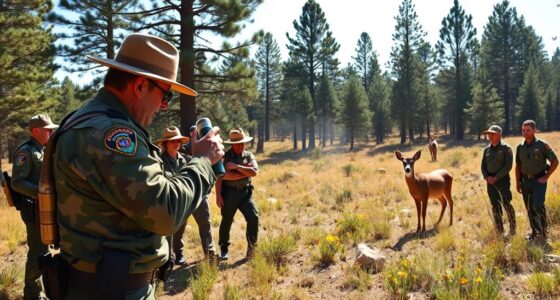Alligator warnings are issued for flooded southern towns as rising waters displace these reptiles, bringing them into urban areas. You should avoid murky floodwaters to reduce the risk of unexpected encounters. Staying aware of your surroundings is crucial, especially with heightened alligator activity during this time. Local authorities recommend reporting any alligator sightings to keep your community safe. For more tips on safety and community preparedness, you might want to keep following updates.
Key Takeaways
- Floodwaters displace alligators, increasing sightings in urban areas and prompting local authorities to issue warnings for safety.
- Residents are advised to avoid murky waters, where alligators may be concealed, to reduce encounter risks.
- Carrying a walking stick is recommended to probe ahead when navigating flooded areas and enhance personal safety.
- Local businesses may suffer due to decreased tourism caused by alligator sightings, emphasizing the need for community safety measures.
- Proactive awareness and reporting of wildlife sightings to authorities can help maintain community safety during flooding events.

As floodwaters rise and wildlife gets displaced, alligators can appear in unexpected places, posing a significant risk to residents. You mightn’t expect to see these reptiles in your neighborhood, but storm-related flooding has made it increasingly common. Heavy rainfall from hurricanes or tropical storms can displace alligators from their natural habitats, forcing them into areas where they typically wouldn’t venture. This creates a unique challenge for communities already dealing with the aftermath of severe weather.
The murky floodwaters can conceal these creatures beneath the surface, making it difficult to spot them. This lack of visibility enhances the danger, as alligators may be lurking nearby while you’re trying to navigate flooded streets. Wildlife officials are alerting residents to the increased activity of alligators in these conditions. With their stress levels heightened, alligators might behave unpredictably, heightening the risk of encounters.
It’s vital to understand how environmental factors contribute to these sightings. Changes in water levels and terrain can push alligators into new territories, increasing the likelihood of them being seen in urban areas. Seasonal variations also play a role, with certain times of the year typically seeing higher alligator activity due to breeding or searching for food. Coupled with human encroachment into their natural habitats, the risk of accidental encounters only grows.
Local authorities are taking proactive measures by issuing warnings and guidelines to help you navigate these flooded areas safely. They recommend avoiding murky waters altogether, as you can’t see what’s lurking beneath. Carrying a walking stick can also improve your safety, as it allows you to probe ahead. Reporting any wildlife sightings to local authorities guarantees they can take appropriate action, helping to keep the community safe.
The presence of alligators can also impact local businesses, particularly those relying on tourism. If your town becomes known for alligator sightings in flooded areas, it might deter visitors. Safety measures, such as fencing off areas known to attract wildlife, are being implemented to protect residents.
As a community member, staying informed and cautious is essential. Floods and the wildlife they displace pose real risks, but with common sense precautions, you can navigate these challenges. Always be aware of your surroundings and prioritize safety as floodwaters recede.
Frequently Asked Questions
How Can I Protect My Pets During Alligator Warnings?
To protect your pets during alligator warnings, keep them on a leash and away from water bodies.
Maintain a safe distance from the water’s edge while walking, and avoid letting them roam unattended.
Reinforce basic commands through consistent training, ensuring they respond quickly.
Secure your yard with sturdy fencing and regularly check for gaps.
Finally, educate your neighbors about alligator safety and encourage them to report any sightings to local authorities.
Are Alligators More Aggressive During Flooding?
Yes, alligators can be more aggressive during flooding.
When their habitats are disrupted, they may feel stressed and threatened, leading to defensive behaviors. As they seek dry land and new territories, they might perceive humans and pets as threats, increasing the potential for aggression.
It’s essential to maintain a safe distance from alligators during these times and to stay aware of their presence to avoid dangerous encounters. Always prioritize safety and caution.
What Should I Do if I See an Alligator?
If you see an alligator, stay calm and avoid direct eye contact.
Back away slowly to give it space and prevent provoking an attack. Don’t feed it or try to interact; this can lead to dangerous situations.
If it’s in a populated area, contact local authorities for safe removal.
Always remember to keep a safe distance, as alligators can be fast and unpredictable, especially if they feel threatened.
How Long Do Alligator Warnings Typically Last?
Alligator warnings typically last until the threat is resolved. This duration depends on factors like the alligator’s size, its proximity to people, and whether it poses an immediate risk.
If you spot a larger alligator or one behaving aggressively, expect warnings to persist longer. Smaller alligators, especially under 4 feet, usually don’t trigger extended warnings unless they venture into residential areas.
Always stay informed and report any concerning sightings to local wildlife authorities.
Can Alligators Swim in Deep Floodwaters?
Yes, alligators can swim in deep floodwaters. They’re excellent swimmers, adapting effortlessly to various water conditions.
In flooded areas, you’ll often see them moving through residential neighborhoods, seeking shelter among vegetation or structures. The deep water provides cover and access to food sources, allowing them to thrive even in unexpected locations.
Just remember, if you encounter one, stay alert and keep a safe distance; their territorial behavior can be unpredictable.
Conclusion
As you navigate the challenges posed by rising waters, keep in mind that the local wildlife is simply taking advantage of their newfound habitat. While it may seem unsettling to share your space with these ancient creatures, remember that they’re just seeking a little adventure too. Stay alert, respect their presence, and embrace the uniqueness of this situation. By doing so, you’ll find a way to coexist with nature’s resilient inhabitants, even in such extraordinary circumstances.










